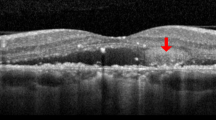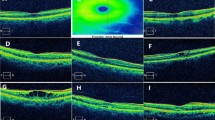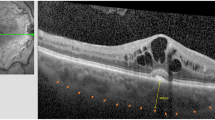Abstract
Purpose
To evaluate choroid thickness and macular retinal metrics in treatment naïve retinal vein occlusion (RVO) patients with serous retinal detachment (SRD) before and after intravitreal anti-vascular endothelial cell growth factor (VEGF) injection and to elucidate the possible role of choroid in the development of SRD and the potential role of SRD as a prognostic parameter.
Methods
This is a retrospective study involving 85 RVO patients, 41 central retinal vein occlusion (CRVO), and 44 branch retinal vein occlusion (BRVO), with macular edema: 21 central retinal vein occlusion and 22 branch retinal vein occlusion with SRD and the rest without SRD. Patients were evaluated with ophthalmic examinations and swept-source optical coherence tomography (SS-OCT) both before and 4–6 weeks after intravitreal anti-VEGF treatment. Choroid thickness and retinal metrics were measured and compared between SRD and non-SRD groups within each RVO subtype.
Results
In both CRVO and BRVO patients, the mean central subfield foveal thickness (CSFT) and central subfoveal choroid thickness (CSCT) of the SRD groups were thicker than those in the non-SRD groups (p < 0.05) at onset. After one anti-VEGF injection, CSFT and FNRT decreased in all groups (p < 0.05). The CSCTs were thicker in the SRD groups compared with the non-SRD groups (p < 0.05). The mean changes of CSFT were more remarkable in the SRD groups (p < 0.05).
Conclusion
Thicker choroid was a feature of naïve RVO patients with SRD and SRD may be an indicator of better anatomical recovery of retina in RVO patients after a single dose of anti-VEGF treatment.




Similar content being viewed by others
Data availability
The datasets presented in this study are available from the corresponding author upon request.
References
Battaglia MP, Isola V (1994) Branch retinal vein occlusion and exudative retinal detachment: pathogenetical aspects. Ophthalmologica 208(1):29–31
Keane PA, Sadda SR (2011) Predicting visual outcomes for macular disease using optical coherence tomography. Saudi J Ophthalmol 25(2):145–158. https://doi.org/10.1016/j.sjopt.2011.01.003
Ota T, Tsujikawa A, Murakami T, Ogino K, Muraoka Y, Kumagai K, Akagi-Kurashige Y, Miyamoto K, Yoshimura N (2013) Subfoveal serous retinal detachment associated with extramacular branch retinal vein occlusion. Clin Ophthalmol 7:237–241. https://doi.org/10.2147/OPTH.S40079
Sekiryu T, Iida T, Sakai E, Maruko I, Ojima A, Sugano Y (2012) Fundus autofluorescence and optical coherence tomography findings in branch retinal vein occlusion. J Ophthalmol 2012:638064. https://doi.org/10.1155/2012/638064
Dacheva I, Ceglowska K, Nobl M, Nowomiejska K, Kretz FT, Reich M, Deuchler S, Tandogan T, Auffarth GU, Koss MJ (2016) Correlation from undiluted vitreous cytokines of untreated central retinal vein occlusion with spectral domain optical coherence tomography. Klin Monatsbl Augenheilkd 233(7):864–868. https://doi.org/10.1055/s-0041-105408
Shin YU, Lee MJ, Lee BR (2015) Choroidal maps in different types of macular edema in branch retinal vein occlusion using swept-source optical coherence tomography. Am J Ophthalmol 160(2):328–334.e1. https://doi.org/10.1016/j.ajo.2015.05.003
Chung SE, Kang SW, Lee JH, Kim YT (2011) Choroidal thickness in polypoidal choroidal vasculopathy and exudative age-related macular degeneration. Ophthalmology 118(5):840–845. https://doi.org/10.1016/j.ophtha.2010.09.012
Reibaldi M, Boscia F, Avitabile T, Uva MG, Russo V, Zagari M, Bonfiglio A, Longo A (2011) Enhanced depth imaging optical coherence tomography of the choroid in idiopathic macular hole: a cross-sectional prospective study. Am J Ophthalmol 151(1):112-117.e2. https://doi.org/10.1016/j.ajo.2010.07.004
Maruko I, Iida T, Sugano Y, Oyamada H, Swkiryu T, Fujiwara T, Spaide RF (2011) Subfoveal choroidal thickness after treatment of Vogt-Koyanagi-Harada disease. Retina 31(3):510–517. https://doi.org/10.1097/IAE.0b013e3181eef053
Hirata M, Tsujikawa A, Matsumoto A, Hangai M, Ooto S, Yamashiro K, Akiba M, Yoshimura N (2011) Macular choroidal thickness and volume in normal subjects measured by swept-source optical coherence tomography. Invest Ophthalmol Vis Sci 52(8):4971–4978. https://doi.org/10.1167/iovs.11-7729
Noma H, Funatsu H, Mimura T, Tatsugawa M, Shimada K, Eguchi S (2012) Vitreous inflammatory factors and serous macular detachment in branch retinal vein occlusion. Retina 32(1):86–91. https://doi.org/10.1097/IAE.0b013e31821801de
Celık E, Doğan E, Turkoglu EB, Çakır B, Alagoz G (2016) Serous retinal detachment in patients with macular edema secondary to branch retinal vein occlusion. Arq Bras Oftalmol 79(1):9–11. https://doi.org/10.5935/0004-2749.20160004
Dogan E, Sever O, Çakır BK, Celik E (2018) Effect of intravitreal ranibizumab on serous retinal detachment in branch retinal vein occlusion. Clin Ophthalmol 12:1465–1470. https://doi.org/10.2147/OPTH.S162019
Gallego-Pinazo R, Dolz-Marco R, Pardo-López D, Martínez-Castillo S, Lleó-Pérez A, Arévalo JF, Llopis-Díaz M (2013) Ranibizumab for serous macular detachment in branch retinal vein occlusions. Graefes Arch Clin Exp Ophthalmol 251:9–14. https://doi.org/10.1007/s00417-012-2023-7
Poon YC, Chen CH, Kuo HK, Chen YJ, Wu PC, Chen YH, Lee JJ (2013) Clinical implications of serous retinal detachment in branch retinal vein occlusion and response after primary intravitreal bevacizumab injection. J Ocul Pharmacol Ther 29(3):319–324. https://doi.org/10.1089/jop.2012.0140
Küük B, Sirakaya E, Karaca C (2019). Comparison of ranibizumab versus aflibercept in treating macular edema among patients with serous retinal detachment secondary to branch retinal vein occlusion. Ocul Immunol Inflamm 1-8. https://doi.org/10.1080/09273948.2019.1681474
Chung YR, Kim JW, Kim SW, Lee K (2016) Choroidal thickness in patients with central serous chorioretinopathy: assessment of Haller and Sattler layers. Retina 36(9):1652–1657. https://doi.org/10.1097/IAE.0000000000000998
Maruko I, Iida T, Sugano Y, Go S, Sekiryu T (2016) Subfoveal choroidal thickness in papillitis type of Vogt-Koyanagi-Harada disease and idiopathic optic neuritis. Retina 36(5):992–999. https://doi.org/10.1097/IAE.0000000000000816
Tsuiki E, Suzuma K, Ueki R, Maekawa Y, Kitaoka T (2013) Enhanced depth imaging optical coherence tomography of the choroid in central retinal vein occlusion. Am J Ophthalmol 156(3):543–547 e1. https://doi.org/10.1016/j.ajo.2013.04.008
Coban-Karatas M, Altan-Yaycioglu R, Ulas B, Sizmaz S, Canan H, Sariturk C (2016) Choroidal thickness measurements with optical coherence tomography in branch retinal vein occlusion. Int J Ophthalmol 9(5):725–729. https://doi.org/10.18240/ijo.2016.05.16
Yumusak E, Ornek K, Dikel NH (2016) Comparison of choroidal thickness changes following intravitreal dexamethasone, ranibizumab, and triamcinolone in eyes with retinal vein occlusion. Eur J Ophthalmol 26(6):627–632. https://doi.org/10.5301/ejo.5000734
Tang F, Xu F, Zhong H, Zhao X, Lv ML, Yang K, Shen CL, Huang H, Lv J, Zeng SM, Li M, Chen Q (2019) Comparison of subfoveal choroidal thickness in eyes with CRVO and BRVO[J]. BMC Ophthalmol 19(1):133. https://doi.org/10.1186/s12886-019-1143-9
Luksch A, Maár N, Tittl M, Ergun E, Findl O, Stur M, Schmetterer L (2002) Evaluation of pulsatile choroidal blood flow in branch retinal vein occlusion. Graefes Arch Clin Exp Ophthalmol 240(7):548–550. https://doi.org/10.1007/s00417-002-0500-0
Catier A, Tadayoni R, Paques M, Erginary A, Haouchine B, Gaudric A, Massin P (2005) Characterization of macular edema from various etiologies by optical coherence tomography. Am J Ophthalmol 140(2):200–206. https://doi.org/10.1016/j.ajo.2005.02.053
Tsujikawa A, Sakamoto A, Ota M, Kotera Y, Oh H, Miyamoto K, Kita M, Yoshimura N (2010) Serous retinal detachment associated with retinal vein occlusion. Am J Ophthalmol 149(2):291–301. https://doi.org/10.1016/j.ajo.2009.09.007
Marmor MF (1990) Control of subretinal fluid: experimental and clinical studies. Eye (Lond) 4(2):340–344
Murakami T, Tsujikawa A, Miyamoto K, Sakamoto A, Ota M, Ogino K, Yoshimura N (2012) Relationship between perifoveal capillaries and pathomorphology in macular oedema associated with branch retinal vein occlusion. Eye (Lond) 26(6):771–780. https://doi.org/10.1038/eye.2012.85
Pfister M, Rothweiler F, Michaelis M, Cinatl J Jr, Schubert R, Koch FH, Koss MJ (2013) Correlation of inflammatory and proangiogenic cytokines from undiluted vitreous samples with spectral domain OCT scans, in untreated branch retinal vein occlusion. Clin Ophthalmol 7:1061–1067. https://doi.org/10.2147/OPTH.S42786
Funding
This work is supported by the Non-profit Central Research Institute Fund of Chinese Academy of Medical Sciences (2018PT32029).
Author information
Authors and Affiliations
Contributions
LLC interpreted the data, drafted this manuscript, and reviewed the literature. MZY helped design the work. MZY and LS collected the data. LLC and SL analyzed the data. MZY revised the manuscript. YXC had the final approval. All authors have read and approved the final manuscript.
Corresponding author
Ethics declarations
Conflict of interest
The authors declare that they have no conflict of interest.
Ethical approval
The study adhered to the tenets of the Declaration of Helsinki and was approved by PUMCH. Informed consent was obtained from all subjects. The research was approved by the institutional review board of PUMCH (approval number: S-K631).
Consent to participate
Written informed consents were obtained from all participants for participating in this study.
Consent for publication
Written informed consents were obtained from all participants for the publication of clinical information and images.
Code availability
Not applicable.
Additional information
Publisher’s note
Springer Nature remains neutral with regard to jurisdictional claims in published maps and institutional affiliations.
Rights and permissions
About this article
Cite this article
Chen, L., Yuan, M., Sun, L. et al. Choroidal thickening in retinal vein occlusion patients with serous retinal detachment. Graefes Arch Clin Exp Ophthalmol 259, 883–889 (2021). https://doi.org/10.1007/s00417-020-04983-3
Received:
Revised:
Accepted:
Published:
Issue Date:
DOI: https://doi.org/10.1007/s00417-020-04983-3




